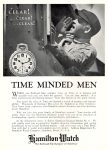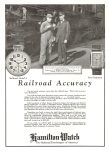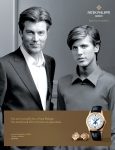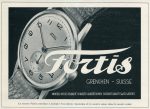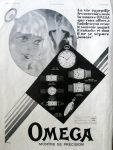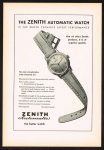Reviews
Watching The Mad Men
Reviews
Watching The Mad Men
Certainly, the world has changed quite a bit since Wanamaker’s day. It’s interesting to see how watch advertising, which was wordy and very “story oriented” has evolved into “product as hero” and “image” concept ads. Most watch companies have settled on trying to find an image or a concept that will make us sit up and pay attention, not an easy feat when experts suggest we are exposed to, on average, more than 5,000 marketing messages a day.
It wasn’t always like this, however. Take a look at the vintage Hamilton ads, which are more like short stories than ads. Rolex was the same way – taking up a complete page of text to explain the concept of the Oyster case.
Certainly, companies advertise to raise awareness and, ultimately, to sell watches.
“Consumers today are always busy, but also constantly hit by many solicitations,” says Carla Liuni, Vice President of Global Marketing and Communication at Bulgari. “The single and final objective of any advertising is to create an impact by generating emotion and desirability towards the brand and product. Therefore, a good ad should be eye-catching in terms of messages and graphic execution. The role of the claim is central here since it captures the viewer’s attention, thus is able to tell a story in which the consumer can both identify himself and dream. In other words, advertising should generate an interaction between the brand and the target consumer to engage the product.”
Where, in the past, watch brands depended on newspaper, magazine and billboard ads almost exclusively, today’s media landscape is much different, with social media, the internet, TV and more offering a confusing and overwhelming slate of options.
“There is more and more diversity on the watch advertising landscape,” says Alain Zimmerman, CEO of Baume & Mercier. “Besides traditional media, like print and outdoor billboards, we see lots of watch brands communicating on digital channels. And not only with corporate creative ads, but also with user-generated content or native advertising. Lots of watch brands still rely on a brand ambassador. Baume & Mercier has a brand ambassador for advertisement in China especially; whereas in western countries, we focus on the celebration message, which is more emotional than just a watch product packshot on a black background.”
The message of a watch brand today is more about building an emotional connection rather than just telling a watch’s story.” “We consider a watch as an emotionally branded consumer product,” says Juan-Carlos Capelli, VP and Head of International Marketing at Longines. “The importance of a watch does not rely that much any more on its function of telling the time but, rather, marks your personal sense of taste and style. An ad should be consistent with the communication strategy of the brand, informing about the product and inviting the consumer to discover the brand’s universe. Of course, a good watch ad should then create a need in the consumer’s mind.”
Where advertising years ago could really inform a consumer, with paragraphs and paragraphs of text, today’s watch ads aim to make an immediate connection in order to stand out from the clutter. The amount of information communicated is much less, but the impact might be even greater.
“Advertising should make people curious about the product,” says Laurent Vinay, Global Communications Director at Jaeger- LeCoultre. “It should trigger an emotion as this will lead to aspiration and build equity for the brand. Until recently there was little differentiation amongst watchmakers in terms of advertising. Ads were either focusing on the product itself or on the image of brand icons – predominantly Hollywood actors. This might be effective for a while but the main drawback is that it does not contribute to building brand equity, which is paramount for any luxury brand.”
It has never been more important to get it right. “Not only has the world become more competitive with much more investments, but there have been the additional needs for social media activities,” says Jean-Claude Biver, CEO of TAG Heuer and Hublot. “As a consequence, advertising has become much more important for the success of a brand than at any period in the history of the Swiss Watch industry.”
When creating advertising concepts, the best advice seems to be this: know thyself. “At Baume & Mercier, our advertisement is strongly linked to our DNA, which is celebrating life’s most important moments,” says Zimmerman. “These moments can be conventional ones – like a birthday or a wedding – but they can also be informal, like a personal achievement or the joy of spending time with friends.”
We asked several companies to explain what they like about their current ad campaigns. Here’s what they had to say:
Bulgari: “Our current campaign ‘Italian Genius’ – for the new Octo Ultranero line – portrays the innovation from the revolutionary technology and design incarnated by Leonardo Da Vinci, one of the most famous Renaissance pioneers, and the iconic strength and power of the Octo watch,” says Liuni. “The Octo has become a mainstay in the watch collections of Bulgari, a house known for its jewellery expertise. The watch is both a precision timepiece and an architectural creation that pays tribute to Italian creative genius.”
Jaeger-LeCoultre: “With our current ad campaign we have managed to break away from traditional watchmaking advertising,” says Vinay. “The personalities we feature in the campaign have a genuine link with the brand itself. They are quite famous in their own way, and though their stories might be simple, that makes them more human in a way. People can relate to them easily and as a result, they can relate to the brand.”
Baume & Mercier: “Under photographer Peter Lindbergh’s sensitive eye, Baume & Mercier reveals intimate, universal photographic stories which seal the decisive and festive moments in each individual’s life,” says Zimmerman. “Time is far more than a succession of seconds, minutes and hours: time is marked by rare moments with which the brand associates. The symbolism of the gift transcends there material reality. This is how the bond that unites a person to those he loves is sealed: the birth of a child, a wedding anniversary, the achievement of a degree or a promotion. Baume & Mercier invites us to remember all these celebrations and to carry them within ourselves, in the same way one wears a cherished object.”
Spreading The Word
The future of advertising is certainly up in the air right now. Print magazines, especially specialty magazines, are still a primary outlet for brands to communicate, but the internet is growing steadily and brands are investing more and more there. But, as Biver warns: “Online is more interactive than print and has more expression fields. Therefore, online cannot just be a translation of the print ads.” So, is a sea change coming, where the bulk of a brand’s investment moves to digital? No one really knows. “The key is being able to adapt the communication to all channels and having complementary artworks or animations according to the speci c target you want to reach,” says Zimmerman.
But, no matter how brands communicate, given the barrage of messages people are exposed to every day, it’s more important than ever to stand out from the crowd. “Being impactful through simple and clear messages is more important than ever before,” Bulgari’s Liuni says. “Watch advertising has changed tremendously over the past 25 years. Previously, product alone was usually the unique protagonist of the ad: the role and the purpose of the ad were mostly commercial. The landscape changed due to the evolution of the market and its actors. Today, there is a fierce competition between hundreds of brands competing on the market and thousands of new products launched every year. This situation favours another approach and way to advertise: the product is today only one element of the ad and is part of a more global environment. The ad tells a story, or at least tries to, by integrating the product in a visual narrative conveying the brand’s universe.”
The advertising world is a fascinating one and as technologies change, everyone has to adapt. It should be interesting to see how things shake out in the next few years. There is one certainty, however, Revolution will remain the number one place to get all your watch news. Nothing beats our glossy paper to make you fall in love with wristwatches.







